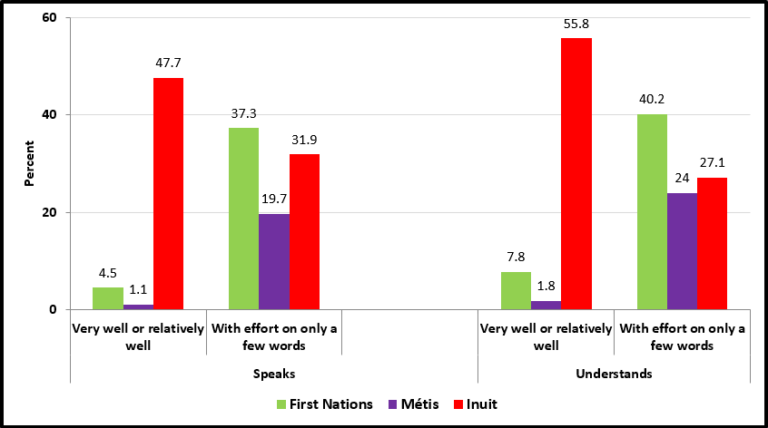6.1.3 Ability of Indigenous children aged 6 to 14 years to speak and understand Indigenous language, by Indigenous identity, Canada, 2012

Note: Excludes persons living on Indian reserves or settlements.
Source: CICH graphic created using data adapted from Statistics Canada. Table 576-0009 – Aboriginal Peoples Survey, self-rated ability to speak and understand an Aboriginal language, by Aboriginal identity, age group and sex, population aged 6 years and over, Canada, provinces and territories, occasional (persons unless otherwise noted).
In 2012, 5% of First Nations children aged 5 to 14 years spoke an Indigenous language well or very well.
That was the case for 1% of Métis children and 48% of Inuit children in the same age group.
8% of First Nations children aged 5 to 14 years understood Indigenous languages well or very well.
That was the case for 2% of Métis children and 56% of Inuit children in the same age group.
Implications
Language is intrinsically linked to the development of strong cultural identity, at both individual and collective levels. It is important to a child’s mental health and well-being,1 to provide him/her with a sense of belonging and self-esteem as a foundation for individual resilience that contributes to the development of strong and resilient communities. In Canada, colonial legislation that aimed to assimilate Indigenous peoples into mainstream society has endangered many Indigenous languages. Of an estimated 450 Indigenous languages and dialects belonging to 11 language families, only 50-70 are still spoken in Canada, and only three (Cree, Inuktitut and Ojibway) are expected to remain and flourish in Indigenous communities. In order to prevent the use of Indigenous languages from dying, it is important that Indigenous children learn their languages.2
1Galley, V., Gessner, S., Herbert, T., Thompson, K.T., & Williams, L.W. (2016). Indigenous languages recognition, preservation and revitalization: A report on the national dialogue session on Indigenous languages. Victoria, BC: First Peoples’ Cultural Council. Retrieved September 12, 2017 from http://www.fpcc.ca/files/PDF/General/FPCC__National_Dialogue_Session_Report_Final.pdf
2McIvor, O. (2005). Building the nests: Indigenous language revitalization in Canada through early childhood immersion programs. Unpublished MA theses, School of Child and Youth Care, University of Victoria, Victoria, BC. https://dspace.library.uvic.ca:8443/handle/1828/686
